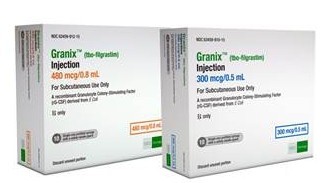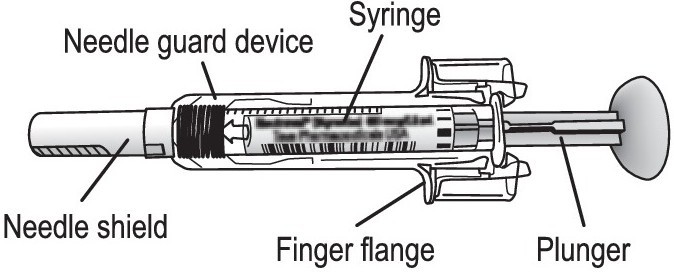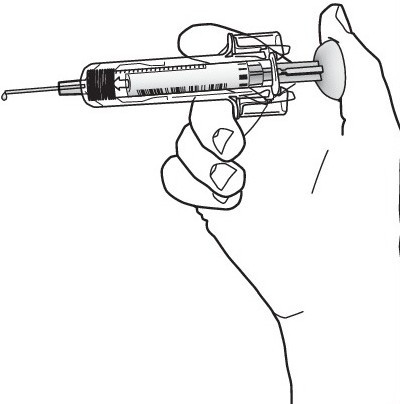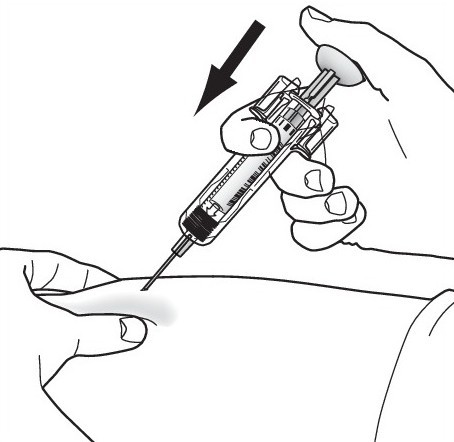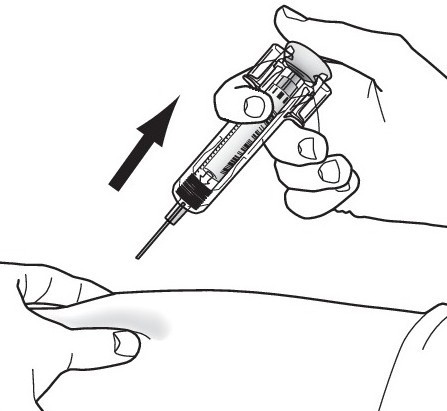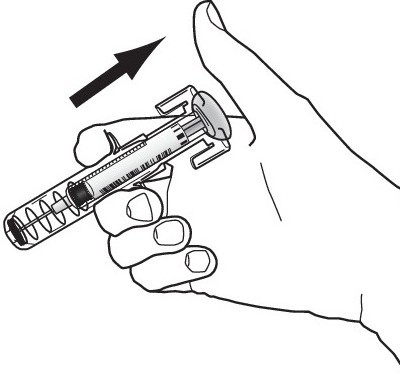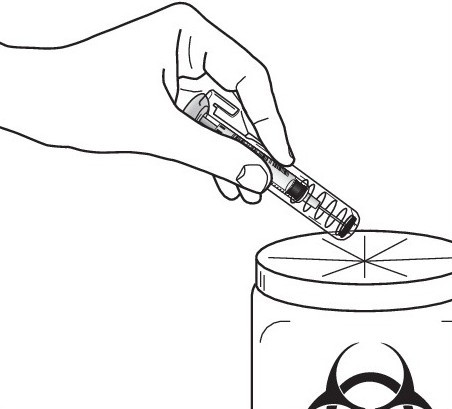|
GRANIX (tbo-filgrastim) injection, solution HIGHLIGHTS OF PRESCRIBING INFORMATION FULL PRESCRIBING INFORMATION 1 INDICATIONS AND USAGE GRANIX is indicated to reduce the duration of severe neutropenia in patients with non-myeloid malignancies receiving myelosuppressive anti-cancer drugs associated with a clinically significant incidence of febrile neutropenia. 2 DOSAGE AND ADMINISTRATION 2.1 Dosage The recommended dose of GRANIX is 5 mcg/kg per day administered as a subcutaneous injection. Administer the first dose of GRANIX no earlier than 24 hours following myelosuppressive chemotherapy. Do not administer GRANIX within 24 hours prior to chemotherapy [see Warnings and Precautions (5)]. Daily dosing with GRANIX should continue until the expected neutrophil nadir is passed and the neutrophil count has recovered to the normal range. Monitor complete blood count (CBC) prior to chemotherapy and twice per week until recovery. 2.2 General Considerations for Administration GRANIX should be administered by a healthcare professional. Visually inspect parenteral drug products for particulate matter and discoloration prior to administration. Do not administer GRANIX if discoloration or particulates are observed. The prefilled syringe is for single use only. Discard unused portions. Recommended sites for subcutaneous GRANIX injections include the abdomen (except for the two-inch area around the navel), the front of the middle thighs, the upper outer areas of the buttocks, or the upper back portion of the upper arms. The injection site should be varied daily. GRANIX should not be injected into an area that is tender, red, bruised or hard, or that has scars or stretch marks. 2.3 Instructions for Use of the Safety Needle Guard Device Hold the syringe assembly by the open sides of the device and remove the needle shield. Expel any extra volume depending on dose needed. Inject GRANIX subcutaneously as recommended [see General Considerations for Administration (2.2)]. Push the plunger as far as it will go to inject all the medication. Injection of the entire prefilled syringe contents is necessary to activate the needle guard. With the plunger still pressed all the way down, remove the needle from the skin. Slowly let go of the plunger and allow the empty syringe to move up inside the device until the entire needle is guarded. Discard the syringe assembly in approved containers. 3 DOSAGE FORMS AND STRENGTHS 300 mcg/0.5 mL in single-use prefilled syringe 480 mcg/0.8 mL in single-use prefilled syringe 4 CONTRAINDICATIONS None. 5 WARNINGS AND PRECAUTIONS 5.1 Splenic Rupture Splenic rupture, including fatal cases, can occur following administration of human granulocyte colony-stimulating factors. In patients who report upper abdominal or shoulder pain after receiving GRANIX, discontinue GRANIX and eva luate for an enlarged spleen or splenic rupture. 5.2 Acute Respiratory Distress Syndrome (ARDS) Acute respiratory distress syndrome (ARDS) can occur in patients receiving human granulocyte colony-stimulating factors. eva luate patients who develop fever and lung infiltrates or respiratory distress after receiving GRANIX, for ARDS. Discontinue GRANIX in patients with ARDS. 5.3 Allergic Reactions Serious allergic reactions including anaphylaxis can occur in patients receiving human granulocyte colony-stimulating factors. Reactions can occur on initial exposure. The administration of antihistamines‚ steroids‚ bronchodilators‚ and/or epinephrine may reduce the severity of the reactions. Permanently discontinue GRANIX in patients with serious allergic reactions. Do not administer GRANIX to patients with a history of serious allergic reactions to filgrastim or pegfilgrastim. 5.4 Use in Patients with Sickle Cell Disease Severe and sometimes fatal sickle cell crises can occur in patients with sickle cell disease receiving human granulocyte colony-stimulating factors. Consider the potential risks and benefits prior to the administration of human granulocyte colony-stimulating factors in patients with sickle cell disease. Discontinue GRANIX in patients undergoing a sickle cell crisis. 5.5 Potential for Tumor Growth Stimulatory Effects on Malignant Cells The granulocyte colony-stimulating factor (G-CSF) receptor through which GRANIX acts has been found on tumor cell lines. The possibility that GRANIX acts as a growth factor for any tumor type, including myeloid malignancies and myelodysplasia, diseases for which GRANIX is not approved, cannot be excluded. 6 ADVERSE REACTIONS The following serious adverse reactions are discussed in greater detail in other sections of the labeling:
The most common treatment-emergent adverse reaction that occurred at an incidence of at least 1% or greater in patients treated with GRANIX at the recommended dose and was numerically two times more frequent than in the placebo group was bone pain. 6.1 Clinical Trials Experience Because clinical trials are conducted under widely varying conditions, adverse reaction rates observed in the clinical trials of a drug cannot be directly compared to rates in the clinical trials of another drug and may not reflect the rates observed in clinical practice. GRANIX clinical trials safety data are based upon the results of three randomized clinical trials in patients receiving myeloablative chemotherapy for breast cancer (N=348), lung cancer (N=240) and non-Hodgkin’s lymphoma (N=92). In the breast cancer study, 99% of patients were female, the median age was 50 years, and 86% of patients were Caucasian. In the lung cancer study, 80% of patients were male, the median age was 58 years, and 95% of patients were Caucasian. In the non-Hodgkin’s lymphoma study, 52% of patients were male, the median age was 55 years, and 88% of patients were Caucasian. In all three studies a placebo (Cycle 1 of the breast cancer study only) or a non-US-approved filgrastim product were used as controls. Both GRANIX and the non-US-approved filgrastim product were administered at 5 mcg/kg subcutaneously once daily beginning one day after chemotherapy for at least five days and continued to a maximum of 14 days or until an ANC of ≥10,000 x 106/L after nadir was reached. Bone pain was the most frequent treatment-emergent adverse reaction that occurred in at least 1% or greater in patients treated with GRANIX at the recommended dose and was numerically two times more frequent than in the placebo group. The overall incidence of bone pain in Cycle 1 of treatment was 3.4% (3.4% GRANIX, 1.4% placebo, 7.5% non-US-approved filgrastim product). Leukocytosis In clinical studies, leukocytosis (WBC counts > 100,000 x 106/L) was observed in less than 1% patients with non-myeloid malignancies receiving GRANIX. No complications attributable to leukocytosis were reported in clinical studies. 6.2 Immunogenicity As with all therapeutic proteins, there is a potential for immunogenicity. The incidence of antibody development in patients receiving GRANIX has not been adequately determined. 7 DRUG INTERACTIONS No formal drug interaction studies between GRANIX and other drugs have been performed. Drugs which may potentiate the release of neutrophils‚ such as lithium‚ should be used with caution. Increased hematopoietic activity of the bone marrow in response to growth factor therapy has been associated with transient positive bone imaging changes. This should be considered when interpreting bone-imaging results. 8 USE IN SPECIFIC POPULATIONS 8.1 Pregnancy Pregnancy Category C There are no adequate and well-controlled studies of GRANIX in pregnant women. In an embryofetal developmental study, treatment of pregnant rabbits with tbo-filgrastim resulted in adverse embryofetal findings, including increased spontaneous abortion and fetal malformations at a maternally toxic dose. GRANIX should be used during pregnancy only if the potential benefit justifies the potential risk to the fetus. In the embryofetal developmental study, pregnant rabbits were administered subcutaneous doses of tbo-filgrastim during the period of organogenesis at 1, 10 and 100 mcg/kg/day. Increased abortions were evident in rabbits treated with tbo-filgrastim at 100 mcg/kg/day. This dose was maternally toxic as demonstrated by reduced body weight. Other embryofetal findings at this dose level consisted of post-implantation loss‚ decrease in mean live litter size and fetal weight, and fetal malformations such as malformed hindlimbs and cleft palate. The dose of 100 mcg/kg/day corresponds to a systemic exposure (AUC0-24) of approximately 50-90 times the exposures observed in patients treated with the clinical tbo-filgrastim dose of 5 mcg/kg/day. 8.3 Nursing Mothers It is not known whether tbo-filgrastim is secreted in human milk. Because many drugs are excreted in human milk, caution should be exercised when GRANIX is administered to a nursing woman. Other recombinant G-CSF products are poorly secreted in breast milk and G-CSF is not orally absorbed by neonates. 8.4 Pediatric Use The safety and effectiveness of GRANIX in pediatric patients have not been established. 8.5 Geriatric Use Among 677 cancer patients enrolled in clinical trials of GRANIX, a total of 111 patients were 65 years of age and older. No overall differences in safety or effectiveness were observed between patients age 65 and older and younger patients. 8.6 Renal Impairment The safety and efficacy of GRANIX have not been studied in patients with moderate or severe renal impairment. No dose adjustment is recommended for patients with mild renal impairment [see Clinical Pharmacology (12.3)]. 8.7 Hepatic Impairment The safety and efficacy of GRANIX have not been studied in patients with hepatic impairment. 10 OVERDOSAGE No case of overdose has been reported. 11 DESCRIPTION Tbo-filgrastim is a non-glycosylated recombinant methionyl human granulocyte colony-stimulating growth factor (r-metHuG-CSF) manufactured by recombinant DNA technology using the bacterium strain E coli K802. It has a molecular weight of approximately 18.8 kDa and is composed of 175 amino acids. The endogenous human G-CSF is glycosylated and does not have the additional methionine amino acid residue in its NH2 terminal end. The product is a sterile, clear, colorless, preservative-free solution containing tbo-filgrastim, glacial acetic acid, sorbitol, polysorbate 80, sodium hydroxide, and Water for Injection. The product is available in single-use prefilled syringes that contain either 300 mcg or 480 mcg of tbo-filgrastim at a fill volume of 0.5 mL or 0.8 mL, respectively. See table below for product composition of each single-use prefilled syringe.
12 CLINICAL PHARMACOLOGY 12.1 Mechanism of Action Tbo-filgrastim is a human granulocyte colony-stimulating factor (G-CSF) produced by recombinant DNA technology. Tbo-filgrastim binds to G-CSF receptors and stimulates proliferation of neutrophils. G-CSF is known to stimulate differentiation commitment and some end-cell functional activation, which increases neutrophil counts and activity. 12.2 Pharmacodynamics In the clinical trials of patients with cancer, the time to the ANCmax was between 3 to 5 days and returned to baseline by 21 days following completion of chemotherapy. In the healthy volunteer trials, doubling the tbo-filgrastim subcutaneous dose from 5 to 10 mcg/kg resulted in a 16%-19% increase in the ANCmax and a 33%-36% increase in the area under the effect curve for ANC. 12.3 Pharmacokinetics In healthy subjects, the absolute bioavailability of 5 mcg/kg subcutaneous tbo-filgrastim was 33%. Increasing the dose of tbo-filgrastim from 5 to 10 mcg/kg in these healthy subjects resulted in an approximately 200% increase in both the maximum concentration (Cmax) and the area under the curve (AUC0-48h) of the drug. In the clinical trials of patients with cancer, the AUC and Cmax were greater and more variable compared to healthy volunteers receiving the same dose of tbo-filgrastim subcutaneously. The median time to maximum concentration was between 4 to 6 hours and the median elimination half-life was between 3.2 to 3.8 hours. Accumulation was not observed after repeated dosing. Pharmacokinetics in Specific Populations Age: Not eva luated. Gender: No gender-related differences were observed. Renal Impairment: Mild renal impairment (creatinine clearance 60 - 89 mL/min) had no effect on tbo-filgrastim pharmacokinetics (N=11). The pharmacokinetic profile in patients with moderate and severe renal impairment has not been assessed. Hepatic Impairment: The pharmacokinetic profile in patients with hepatic impairment has not been assessed. 12.6 QT/QTc Prolongation The potential effects of GRANIX on the QTc interval were not adequately eva luated in clinical trials. 13 NONCLINICAL TOXICOLOGY 13.1 Carcinogenesis, Mutagenesis, Impairment of Fertility Carcinogenicity and genetic toxicology studies have not been conducted with tbo-filgrastim. A fertility study was not conducted with tbo-filgrastim. Toxicology studies of up to 26 weeks in rats or monkeys did not reveal findings in male or female reproductive organs that would suggest impairment of fertility. 14 CLINICAL STUDIES The efficacy of GRANIX was eva luated in a multinational, multicenter, randomized and controlled Phase 3 study in 348 chemotherapy-naive patients with high-risk stage II, stage III, or stage IV breast cancer receiving doxorubicin (60 mg/m2) and docetaxel (75 mg/m2) comparing GRANIX to placebo and a non-US-approved filgrastim product as controls. The median age of the patients was 50 years (range 25 to 75 years) with 99% female and 86% Caucasian. GRANIX, placebo, and the non-US-approved filgrastim product were administered at 5 mcg/kg subcutaneously once daily beginning one day after chemotherapy for at least five days and continued to a maximum of 14 days or until an ANC of ≥10,000 x 106/L after nadir was reached. GRANIX was superior to placebo in duration of severe neutropenia (DSN) with a statistically significant reduction in DSN (1.1 days vs. 3.8 days, p < 0.0001). 16 HOW SUPPLIED/STORAGE AND HANDLING GRANIX solution for injection is supplied as a single-use, preservative-free, prefilled syringe of Type I glass which has a permanently attached stainless steel needle. Syringes may be supplied with or without an UltraSafe Passive® Needle Guard. The active substance is tbo-filgrastim. GRANIX 300 mcg/0.5 mL: Each prefilled syringe contains 300 mcg of tbo-filgrastim in 0.5 mL solution with a blue plunger in:
GRANIX 480 mcg/0.8 mL: Each prefilled syringe contains 480 mcg of tbo-filgrastim in 0.8 mL solution with a clear plunger in:
GRANIX syringes should be stored in a refrigerator at 36° to 46° F (2° to 8° C). Protect from light. Within its shelf life, the product may be removed from 36° to 46° F (2° to 8° C) storage for a single period of up to 5 days between 73° to 81° F (23° to 27° C). If not used within 5 days, the product may be returned to 36° to 46° F (2° to 8° C) up to the expiration date. Avoid shaking. The solution should be visually inspected prior to use. Only clear solutions without particles should be used. Exposure to 23° to 30° F (-1° to -5 °C) for up to 72 hours and temperatures as low as 5° to -13° F (-15 to -25° C) for up to 24 hours do not adversely affect the stability of GRANIX. Single-use syringe – discard unused portion. Any unused product or waste material should be disposed of in accordance with local requirements. | ||||||||||||||||||||||||
GRANIX(TBO-非格司亭)注射液简介:
GRANIX (tbo-filgrastim) injection, solution[Cephalon公司]
HIGHLIGHTS OF PRESCRIBING INFORMATIONThese highlights do not include all the information needed to use GRANIX safely and eff ... 责任编辑:admin |
最新文章更多推荐文章更多热点文章更多
|


